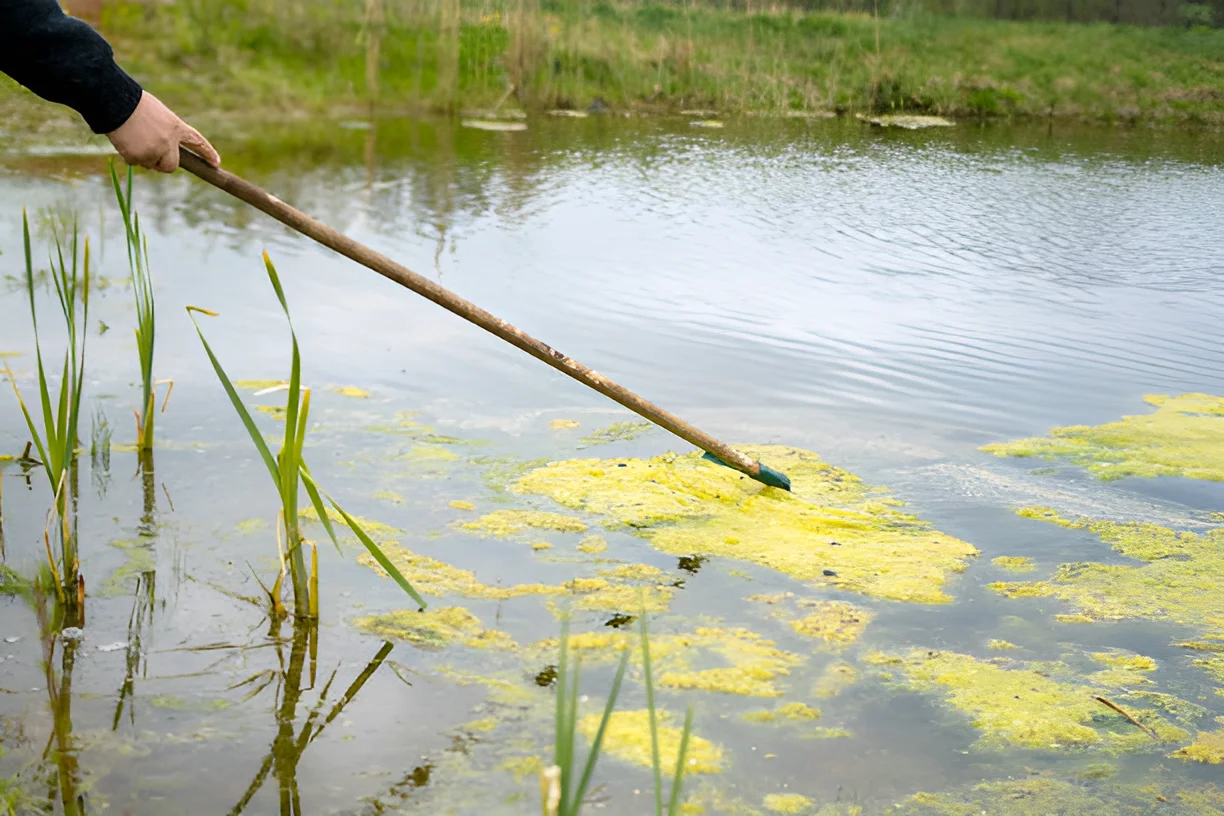Yes, pond algae, particularly blue-green algae, can make a dog very sick and can even be fatal. Understanding the risks and symptoms of algae poisoning is crucial for keeping your dog safe.
Understanding Pond Algae and Its Risks
Pond algae, especially blue-green algae (cyanobacteria), can pose significant health risks to dogs. These algae are commonly found in stagnant or slow-moving water bodies, such as ponds, lakes, and reservoirs, particularly during warm weather.
1. What is Blue-Green Algae?
Blue-green algae, or cyanobacteria, are microscopic organisms that thrive in warm, nutrient-rich water. Despite their name, they are not true algae but bacteria that can produce harmful toxins.
- Appearance: Blue-green algae can appear as green, blue, or brown scum on the water’s surface. It often looks like paint or pea soup and can produce a foul odor.
- Toxin Production: These bacteria can produce toxins that are harmful to both animals and humans. The most common toxins are microcystins and anatoxins, which can cause severe liver and neurological damage.
2. Why Are Dogs at Risk?
Dogs are particularly vulnerable to blue-green algae poisoning due to their behaviors and tendencies.
- Water Play: Dogs love to swim and play in water, increasing their risk of exposure to contaminated water.
- Ingestion: Dogs may drink the contaminated water or lick their fur after swimming, ingesting the toxins.
- Curiosity: Dogs are naturally curious and may explore areas with algae blooms, putting them at risk of exposure.
Symptoms of Algae Poisoning in Dogs
Recognizing the symptoms of algae poisoning is crucial for prompt treatment. Symptoms can appear within minutes to hours after exposure and can vary depending on the type of toxin ingested.
1. Gastrointestinal Symptoms
Gastrointestinal symptoms are often the first signs of algae poisoning.
- Vomiting: Sudden vomiting is a common symptom and can occur shortly after ingestion.
- Diarrhea: Diarrhea, sometimes bloody, can also be a sign of poisoning.
- Loss of Appetite: Affected dogs may refuse to eat and show signs of nausea.
2. Neurological Symptoms
Neurological symptoms indicate severe poisoning and require immediate veterinary attention.
- Weakness and Lethargy: Dogs may become weak, lethargic, and unresponsive.
- Disorientation: Disorientation and confusion are common neurological symptoms.
- Seizures: Seizures can occur in severe cases and indicate significant neurological damage.
- Tremors: Muscle tremors and twitching are also signs of severe poisoning.
3. Liver Damage Symptoms
Liver damage caused by microcystins can lead to severe health issues.
- Jaundice: Yellowing of the skin, gums, and whites of the eyes is a sign of liver damage.
- Abdominal Pain: Dogs may show signs of abdominal pain and discomfort.
- Increased Thirst and Urination: Increased thirst and urination can indicate liver dysfunction.
Immediate Actions and Treatment
If you suspect your dog has been exposed to blue-green algae, immediate action is crucial. Quick response can save your dog’s life.
1. Immediate Actions
Take the following steps immediately if you suspect algae poisoning:
- Remove Your Dog from the Water: Get your dog out of the contaminated water immediately to prevent further exposure.
- Rinse Thoroughly: Rinse your dog with clean, fresh water to remove any algae from their fur and skin.
- Prevent Further Ingestion: Prevent your dog from licking their fur or drinking more water.
2. Seek Veterinary Care
Contact your veterinarian immediately for advice and treatment.
- Emergency Visit: Take your dog to the nearest veterinary clinic or emergency animal hospital.
- Provide Information: Inform the vet about the possible exposure to blue-green algae and describe the symptoms.
3. Veterinary Treatment
Veterinary treatment for algae poisoning focuses on supportive care and managing symptoms.
- Inducing Vomiting: If the ingestion was recent, the vet might induce vomiting to remove the toxins.
- Activated Charcoal: Administering activated charcoal can help absorb the toxins in the digestive system.
- IV Fluids: Intravenous fluids are often given to maintain hydration and support liver and kidney function.
- Medications: Medications to control seizures, tremors, and other symptoms may be necessary.
Preventing Algae Poisoning
Prevention is the best way to protect your dog from algae poisoning. Here are some tips to keep your dog safe:
1. Avoid Contaminated Water
Keep your dog away from water bodies that may be contaminated with blue-green algae.
- Check Water Quality: Before allowing your dog to swim, check the water for signs of algae blooms. Avoid water that looks discolored, has scum on the surface, or smells bad.
- Stay Informed: Stay informed about local water quality advisories and avoid areas with known algae blooms.
2. Supervise Water Play
Always supervise your dog when they are near water.
- Leash Your Dog: Keep your dog on a leash near water bodies to prevent them from jumping in without your knowledge.
- Provide Fresh Water: Bring fresh water for your dog to drink to prevent them from drinking from ponds or lakes.
3. Regular Cleaning
Regularly clean and maintain any backyard ponds or pools to prevent algae growth.
- Routine Cleaning: Clean your pond or pool regularly to remove debris and prevent algae growth.
- Use Algaecides: Use pet-safe algaecides to control algae growth in your pond or pool.
Conclusion
Pond algae, particularly blue-green algae, can make a dog very sick and can even be fatal. Recognizing the symptoms of algae poisoning and taking immediate action can save your dog’s life. Preventing exposure by avoiding contaminated water and supervising your dog during water play is crucial. Always seek veterinary care if you suspect your dog has been exposed to toxic algae.
The photo featured below the post headline is Credit: Ja’Crispy/istockphoto
I hope you find this post helpful and informative. If Yes’ feel free to share it with your friends!
Frequently Asked Questions
What are the symptoms of blue-green algae poisoning in dogs?
Symptoms include vomiting, diarrhea, weakness, disorientation, seizures, and jaundice. Immediate veterinary care is essential.
How can I prevent my dog from getting algae poisoning?
Avoid letting your dog swim in or drink from water bodies with visible algae blooms, supervise water play, and provide fresh drinking water.
What should I do if my dog has been exposed to blue-green algae?
Remove your dog from the water, rinse them thoroughly with fresh water, and seek immediate veterinary care.
Can blue-green algae affect humans?
Yes, blue-green algae can produce toxins that are harmful to humans as well as animals. Avoid contact with contaminated water.
Are there any treatments for blue-green algae poisoning?
There is no specific antidote, but supportive care such as IV fluids, medications to control symptoms, and activated charcoal can help manage the condition.

